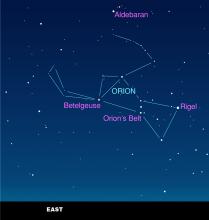Orion Rising [1]
The most visually impressive constellation in all the night sky climbs to prominence on December nights. It’s a sight you don’t want to miss.
Orion the hunter clears the eastern horizon by about 8 p.m. And it’s easy to find. Look for its “belt” of three moderately bright stars, which aims straight up into the sky as the constellation rises. It’s flanked by Orion’s brightest stars — orange Betelgeuse to the left, and blue-white Rigel to the right. And two other bright stars team up with them to complete a rectangle around the belt.
All seven of the stars that mark the rectangle and the belt look bright because they really are bright. They’re all supergiants — stars that are much bigger and heavier than the Sun, and tens of thousands of times brighter.
Such stars blaze through their nuclear fuel in a hurry, so they live short lives — tens of millions of years, compared to billions of years for a star like the Sun. And when such a star expires, it blasts itself to bits as a supernova.
Even more giants are being born in the Orion Nebula. It’s in Orion’s sword, which extends to the lower right of the belt. The nebula looks like a faint, fuzzy star. But it’s really a stellar nursery that’s given birth to thousands of stars, with many more still being incubated. That includes several supergiants, which light up the surrounding gas and dust. They, too, will blast themselves apart — briefly adding to the luster of this amazing constellation.
Script by Damond Benningfield


